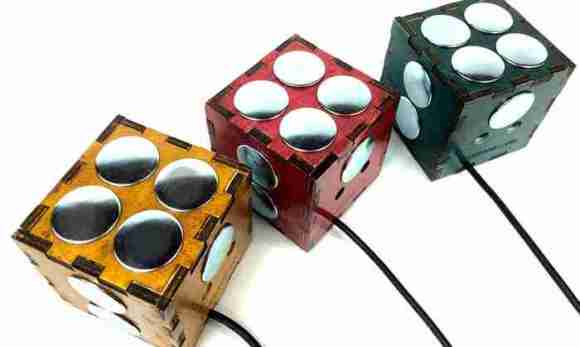 [Keith Baxter] loves making electronic instruments. His latest vision has come to life as Kyub, an open-source MIDI keyboard. [Keith] has previously graced our site and cracked Popular Science with his servoelectric guitar.
[Keith Baxter] loves making electronic instruments. His latest vision has come to life as Kyub, an open-source MIDI keyboard. [Keith] has previously graced our site and cracked Popular Science with his servoelectric guitar.
[Keith] wanted to make a completely open source instrument that’s elegant, useful, and a bit more accessible than the servoelectric guitar, so he teamed up with a hacker/electronic music expert and an industrial designer. He built the early prototypes around an Arduino Uno. The current iteration uses a Teensy 2.0 and is available in various forms through Kickstarter. [Keith] opened the Kyub up to crowd funding in an effort to obtain volume pricing on some of the parts as well as an Eagle license to make the PCB files available commercially.
The Kyub has eleven pressure-sensitive capacitive keypads on five sides of the cube. The accelerometer can be used to vary note volume, bend the pitch, or whatever else you program it to do. Of course, you’ll need a computer with a synthesizer program, but [Keith] says it is compatible with most software synth programs, some of which are free.
There’s a demo video of an early prototype after the break. Videos of the Kyub in its current form are available on the Kickstarter page.















That’s pretty awesome!
Thanks. A lot lighter than my servoelectric guitar too :)
Love the colored, laser cut boxes.
Should have used Kicad. Oh well.
Bummer it’s limited to synth programs and not real synths. Why no real midi output?
I wondered that too. The original one had a MIDI output socket, but on Kickstarter it’s MIDI over USB. Undoubtedly someone smart could hack together a small shell script to pass the data stream from the USB input to a MIDI output.
I myself am more interested in why this has to use a Teensy, and not simply a microcontroller. The Teensy 2.0 is $16, but the Atmel chip on it is only $6.18 from Mouser (for example). Since they are going to roll a PCB they might as well drop the footprint for the ATMEGA32U4 on there and be done with it. That’s $700 savings (across 70 units) right there. Using Kicad would save having to pay for an Eagle license too.
Maybe that’s being kept back for Mk II.
We’ll post the eagle files for the MIDI out version–its really easy, just a 220 ohm resistor on one pin and the MIDI DIN connector. The decision to go USB MIDI was mostly to get the cost down to Kickstarter levels. You can use the USB power (no wall adaper) and get rid of the MIDI connector, housing, screws etc. The Teensy is because it supports USB MIDI. Most computer synths don’t accept USB serial data (I think).
Thanks for the tip on Kicad–I’ll give it a try. Thanks Hack-a-day!
What is the advantage to the cube layout over a regular keyboard shape?
Seems like it’d just be awkward to play.
Good question. The cube design give you good pad density of large pads in a hand held form factor and lets you do some nifty “bounce” fingering on two sides (see http://youtu.be/c8jTPrNmOzo). Otherwise, we are thinking it could be used to change the programming by rotating the up-facing side, let you map different instruments to different faces and maybe make it easier to remember note patterns than a linear, planar surface. Part of the idea of this project was to see what people (muiscian-programmer-hackers) could do figure out. I will say it is more fun than my tiny USB keyboard.
Open source?, I don’t see the source code anywhere. Great project though!
One of our Kickstarter rewards ($5) is early release of the open source, PCBs etc to build support for our bulk parts purchase. The source code will go up a couple weeks after the end of the campaign, so keep watching. Thanks for the interest–we could use some programmers like you!
Can you play Malvina Reynolds hit “Little Boxes” ?
And they’re all made out of ticky tacky and they all look just the same…
Got to be one of worst interfaces ever. How many times I’ve had to tell people at work to put the item on the bench and work on it without it moving, instead of handling it and making a clumsy job of it. Or better yet clamping it in the vise or to the bench. This goes along with the AADHD effect of scattered pics on a multitouch screen instead of thumbnails in a grid. The first A is for acquired. There are some great alternative interfaces for music creation and performance, this…no.
Ouch. Not even a little great? Check out this video: http://youtu.be/ABR3rfjFJlc